Hamlet, WV
Introduction
Text-to-speech Audio
Images
This 1932 aerial photo includes Hamlet in the center of the picture. The extent of deforestation is evident.
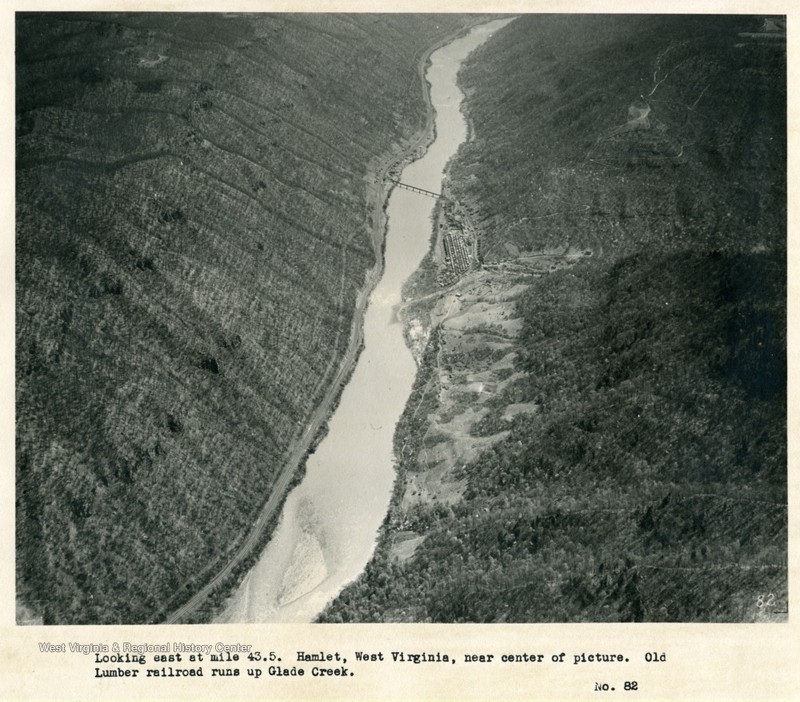
The rail yard and mills in Hamlet. These lines did not connect to the main C&O lines; products had to moved across the river for full access.
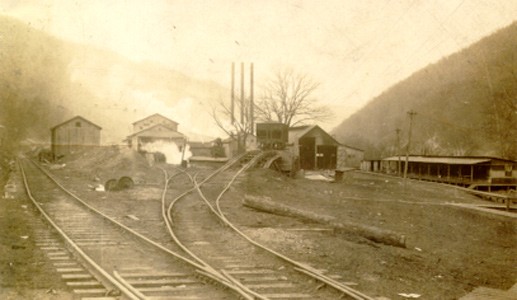
Lumber stacked for processing.
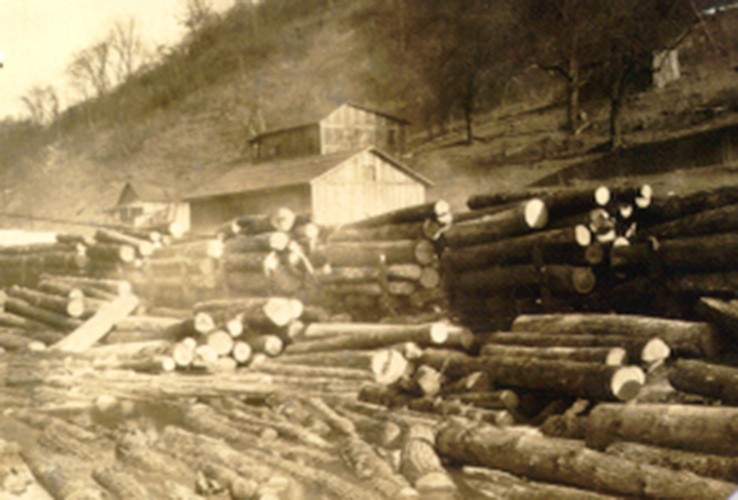
The residential section of Hamlet included about twenty-two houses, many of which would have been shared by more than one family.
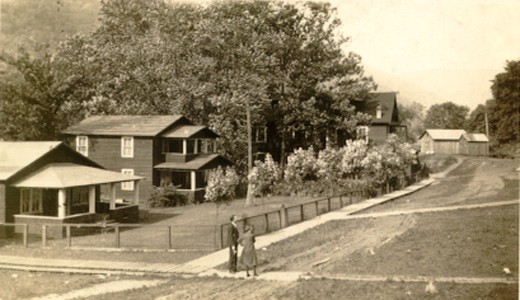
The bridge between Hamlet and Glade was constructed between 1921-1923 and torn down in the mid-1940s to provide raw materials for World War II.
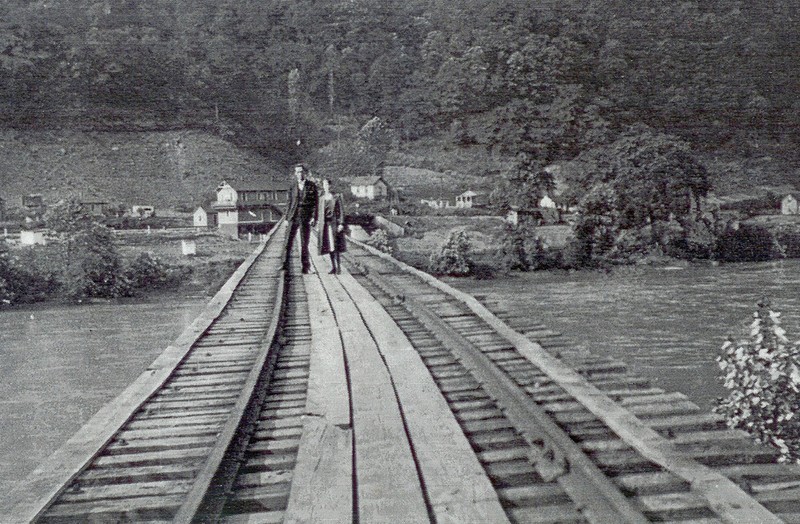
Remaining piers of the bridge between Hamlet and Glade.
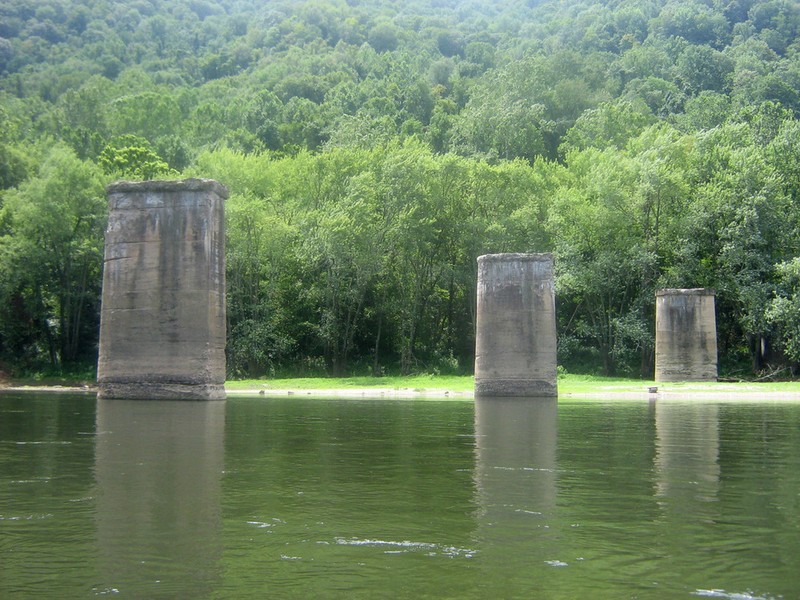
Foundations such as this one are all that is left of Hamlet.
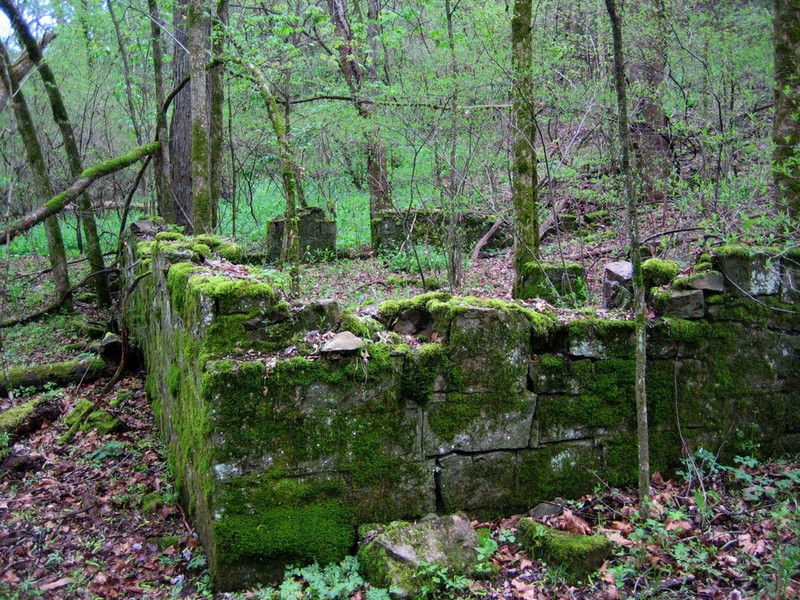
Backstory and Context
Text-to-speech Audio
Like most New River communities, the town of Hamlet sprang up in the late nineteenth century. Following the completion of the main line of the Chesapeake & Ohio Railroad in 1873, many branch lines were constructed to connect outlying areas to the primary thoroughfare. Though there were likely some inhabitants in the relatively remote area in the 1870s, Hamlet was populated in earnest between 1880 and 1890. The primary draw of the area was almost 50,000 acres of pine and yellow poplar trees. Though coal was the immediate business motivator in the New River Gorge, industrialists quickly realized that they could also leverage the existing rail infrastructure to move timber as well.
The Blue Jay Lumber Company was one of the first entities to begin harvesting timber from the region. Hamlet was the primary base of operations and staging area for even more remote communities, such as Glen Morgan upriver. Raw timber was loaded onto freight cars of the Glade Creek rail line and moved to Hamlet. At its peak, the Glade Creek line operated four locomotives, one passenger car, thirty-three freight cars, and twenty-four other unspecified cars. Once in Hamlet, the wood was processed and sent across the river to Hamlet’s companion town, Glade. In Glade, the processed items were loaded onto C&O cars on the branch line and shipped to Thurmond, Hinton, Quinnimont, or Prince, where they were redistributed and delivered to industrial sites in major cities such as Cleveland and Pittsburgh. The entire operation centered on Hamlet comprised a lion’s share of the New River Gorge’s timber industry.
Despite the importance and size of Hamlet’s industry, the town was relatively small. Historical maps indicate that the settlement included around twenty-two houses, though many of these were likely shared by more than one family. Based on similarly sized towns in the New River area, Hamlet was likely home to between one hundred and two hundred people. Most of the residents would have been loggers or mill workers. Each day, loggers would trek up the mountains to the constantly receding woodline and begin felling trees by hand. The timber was then transported down the mountain with the help of draft horses, or in some cases, narrow rail-like tracks, similar to ones used for mining. A mill pond in Hamlet was used to wash timber fresh from the hill. A lumber mill did the initial work of breaking timber into manageable pieces. Some of these were shipped as is while others were further refined at the saw mill. There was also a machine shop in Hamlet, though it is likely that it fabricated items solely for use in the town, rather than producing for other locations.
In addition to logging and mill work, there was also a need for support services in Hamlet. These included a barber shop, doctor’s office, and ice house. A boarding house served visitors and temporary workers while a company store offered opportunities for residents to purchase essential items. Interestingly, there was only a single church and school in Hamlet. Most towns in the New River Gorge recruited and employed significant numbers of Black workers. Due to policies of segregation and general racism, most towns contained separate church and school facilities for white and Black residents. That there was only a single church and school in Hamlet indicates that either a significant portion of workers in the town were white, or that masses and classes were not segregated, with the former being the more likely explanation.
Hamlet enjoyed over thirty-five years of relative prosperity but by 1917, the lumber boom was drawing to a close. This was due in large part to severe overlogging in West Virginia — all of the state’s old-growth forests were completely decimated by 1930. Hamlet rapidly declined and in 1921 only a few families occupied the five remaining homes in the town. All of these residents were employed either by the C&O railroad, or at coal mines down the river. Despite the dire straits Hamlet found itself in, a revival occurred in 1921. The Glade Creek Coal and Lumber Company announced the building of a bridge between Glade Creek and Hamlet and the reintroduction of logging to the area. The Glade Creek rail line was also expanded to allow larger trains. The American Bridge Company was contracted to build the seven hundred fifty foot long girder bridge which was completed in 1923. A new sawmill was also constructed on the Hamlet side of the river.
The Glade Creek Coal and Lumber Company continued operations in the Hamlet area until 1929, when they sold their holdings to the Babcock Coal and Timber Company. Babcock Coal and Timber Company continued commercial operations until 1936, when they closed the mills, possibly due to a devastating fire that destroyed a major mill structure in Hamlet. At the same time, Hamlet’s post office moved across the river to Glade Creek, signalling the finality of Hamlet’s economic prosperity. Babcock Coal and Timber Company went out of business in the late 1930s and removed the rails that connected Hamlet to most other communities. Though a few families still attempted to live in Hamlet, the final nail in the coffin came when the bridge between Hamlet and Glade was deconstructed for metal scrap during World War II. At this point, the isolated town was abandoned and the structures allowed to collapse. Only foundations of major structures and the piers of the dismantled bridge can be seen at Hamlet these days. Despite being no longer extant, Hamlet is the most significant example in the New River Gorge of an industrial settlement devoted to timber rather than coal mining.
Sources
Bragg, Melody. Thurmond and Ghost Towns of the New River Gorge. Glen Jean, WV. Gem Publications, 1995.
Glade Creek/Hamlet, National Park Service. December 19th 2019. Accessed May 12th 2021. https://www.nps.gov/neri/learn/historyculture/glade-creek-hamlet.htm.
Stahlgren, Lori et al. Historical Archaeological Survey: New River Gorge National River and Gauley River National Recreation Area. Lexington, KY. Kentucky Archaeological Survey, 2007.
Workman, Michael E. Maddex, Lee R. Bonenberger, Dan J. New River Gorge National River: Historic Resource Study NERI-02-038 HRS. WV. Institute for the History of Technology & Industrial Archaeology, 2005. Report submitted to New River Gorge National River US Dept. of Interior, National Park Service Cooperative Agreement No. H0001010032.
“New River Near Hamlet, West Virginia.” 1932. West Virginia & Regional History Center. Accessed May 12th 2021.
“RR Tracks and Lumber Mill.” National Park Service. Accessed May 12th 2021. https://www.nps.gov/media/photo/gallery-item.htm?pg=3601600&id=C9434F01-155D-451F-67D04432479E6A53&gid=C8C80BA6-155D-451F-67158AC7E5829BF5.
“Timber.” National Park Service. Accessed May 12th 2021. https://www.nps.gov/media/photo/gallery-item.htm?pg=3601600&id=C95D3B5D-155D-451F-67D3539FE7168D8C&gid=C8C80BA6-155D-451F-67158AC7E5829BF5.
“Hamlet Townsite.” National Park Service. Accessed May 12th 2021. https://www.nps.gov/media/photo/gallery-item.htm?pg=3601600&id=C917AF9F-155D-451F-671CE7F0B904B071&gid=C8C80BA6-155D-451F-67158AC7E5829BF5.
“Glade-Hamlet Bridge.” National Park Service. Accessed May 12th 2021. https://www.nps.gov/media/photo/gallery-item.htm?pg=3601600&id=C8DC4E99-155D-451F-67BE1436DE7DF0CC&gid=C8C80BA6-155D-451F-67158AC7E5829BF5.
“Spanning the River.” National Park Service. Accessed May 12th 2021. https://www.nps.gov/media/photo/gallery-item.htm?pg=3601600&id=CA17D112-155D-451F-677334C49E365D80&gid=C9742179-155D-451F-67B5411B9EEED535.
Bieri, Dave. “Stone Walls.” National Park Service. Accessed May 12th 2021. https://www.nps.gov/media/photo/gallery-item.htm?pg=3601600&id=C99D6A43-155D-451F-679555990288F56E&gid=C9742179-155D-451F-67B5411B9EEED535.
